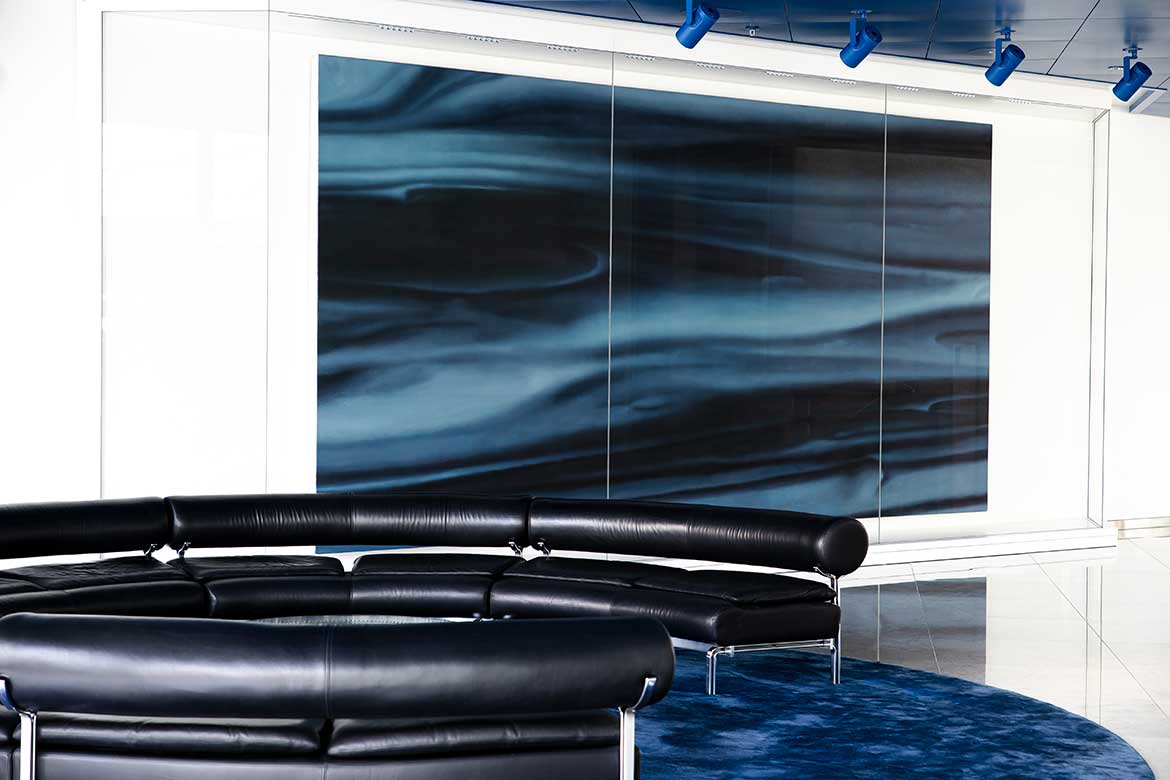The three monumental paintings were created site-specific for the BMW Group Headquarters’ entrance foyer in 1973. After extensive restoration, the works are again presented for all visitors and employees at the location chosen by the artist.
05.10.2023
Gerhard Richter’s “Red – Yellow – Blue“ group is a fascinating series of paintings; brushstrokes opulently enlarged, combining colour and form in a harmonious yet challenging way. For 50 years, they have been the centrepiece of the entrance foyer of the BMW four-cylinder headquarters building. The paintings have been extensively restored to mark this anniversary and are newly presented in specially designed glass showcases.
Munich. Gerhard Richter, one of the most renowned contemporary painters, has had an enduring influence on the art world. His “Red – Yellow – Blue“ group is a fascinating series of paintings; brushstrokes opulently enlarged, combining colour and form in a harmonious yet challenging way. For 50 years, they have been the centrepiece of the entrance foyer of the BMW four-cylinder headquarters building, Karl Schwanzer’s architectural icon – arguably the world’s most spectacular corporate lobby. The paintings have been extensively restored to mark this anniversary and are newly presented in specially designed glass showcases.
The BMW Group commissioned the comprehensive restoration of this impressive group of works as part of its long-term commitment to culture and art. The latest technologies and techniques were used to restore the original brilliance and intensity of Richter’s colours while respecting the integrity of his original vision. From now on, the paintings will be presented in specially built UV-protected and air-conditioned glass showcases that meet modern conservation standards, yet recreate the presentation originally envisaged by the artist.
“Gerhard Richter’s art inspires, provokes and stimulates us to think in fresh ways that transcend the limitations of colour and form,” says Ilka Horstmeier, Member of the Board of Management of BMW AG, Human Resources and Real Estate. “We are proud to present his group of works in our Headquarters in a new way which honors their significance. Richter’s paintings are the nucleus of our 50-year-long commitment to international culture, reason enough on its own for them to be so very close to our hearts.”
Richter’s works were often created from photographs of colour samples that he had personally mixed on a palette. The three “Red – Yellow – Blue” large-format paintings, which Richter created in 1973 for BMW Headquarters in Munich, are highlights of this artistic approach. The group of works, never shown outside the foyer, marks the first conclusion of Richter’s exploration of the palette motif. He subsequently also concentrated on abstract painting, which resulted from mixing the three primary colours on the canvas, or on paintings in which he created lively pictorial surfaces with grey structures. Richter’s work is often formulated from photographic originals collected in his “Atlas”, a collection of photographs, collages, and sketches that he has amassed since 1962 and which is housed in the Städtische Galerie im Lenbachhaus in Munich.
Dr Matthias Mühling, director of the Städtische Galerie im Lenbachhaus und Kunstbau in Munich, adds: “Gerhard Richter’s ‘Red – Yellow – Blue’ represents a significant exploration of the possibilities and limits of painting. Richter explores the very essence of painting itself by using the three primary colours that form the basis of all other colours. The group shows his ongoing exploration of abstraction and figuration, and how these two poles of painting can influence and inform each other. Richter makes us realise through these works that painting is both a means of representing and abstracting reality and challenges us to rethink our own ideas of what painting can be.”
The restoration of the three-by-six-metre “Red – Yellow – Blue” paintings is a remarkable undertaking that calls for the use of modern technologies and techniques. Richter’s artworks had lost some of their colour brilliance over the years. Therefore the restoration’s main aim was to restore the original depth of colour and unity of these masterpieces. A team of experts, including art historians, material scientists and restorers, used innovative techniques to tackle this formidable task and create an authentic restoration plan.
“It took precision, care, and patience to restore the three large-scale paintings. The original substance was extensively conserved and restored in the process. Fine colour transitions and nuances were restored using specially developed colour blends. The original depth of colour and unity is once again revealed and Gerhard Richter’s impressive work brought to life again for BMW,” explains restorer Ekkehard Kneer.
The first publication on the group of works was the volume “Gerhard Richter. Red – Yellow – Blue. The Paintings for BMW” from Prestel Publishing in 2007. It illustrates the development of Richter’s pictorial motifs and poses questions about modernism and the transition to postmodernism. The context of the paintings and the history of the location – the BMW Group plant in Munich, the Olympic grounds, and BMW Headquarters – is also explored.



